Unconventional Mortgage Loans Are Making a Comeback
Lenders are making it easier to get loans, but a repeat of the housing crisis isn’t in the cards.

In 2018, the number of unconventional mortgages increased to the highest level since the mortgage meltdown in 2008. Unconventional mortgages include subprime loans, which are made to borrowers with blemished credit; loans made to borrowers without a Form W-2 or other standard documents; and other loans that don’t meet the standards set by the Consumer Financial Protection Bureau.
Most of the bad-apple loans that contributed to the housing crisis are long gone.
Does that mean we’re headed back to the bad old days that led to the housing meltdown? Probably not, although if there’s a rise in delinquencies, it could signal trouble ahead, says Guy Cecala, publisher of Inside Mortgage Finance.
While the number of unconventional mortgages has grown, they were still less than 3% of loans made in 2018, compared with 39% in 2006, right before the housing bust began. In addition, many of the loans are only slightly unconventional, says Cecala. For starters, most lenders must, by law, make a good-faith effort to determine that a borrower has the “ability to repay,” he says. And lenders that underwrite these mortgages usually look for ways to offset risk. For example, they’ll use a high credit score and a large down payment to offset the risk of a high debt-to-income ratio, limited documentation or an interest-only loan.

Sign up for Kiplinger’s Free E-Newsletters
Profit and prosper with the best of expert advice on investing, taxes, retirement, personal finance and more - straight to your e-mail.
Profit and prosper with the best of expert advice - straight to your e-mail.
Most of the bad-apple loans that contributed to the housing crisis are long gone. Loans that result in negative amortization—the loan balance grows rather than shrinks—have disappeared. Interest-only loans have returned to their traditional role as short-term loans for wealthy people buying expensive homes with a down payment of, say, 50%, says Cecala.
The primary reasons that borrowers took unconventional loans in 2018 were that they had limited or alternative documentation, they had a debt-to-income ratio above 43%, or they wanted an interest-only loan, according to CoreLogic, a financial data and analytics company. Borrowers who are self-employed or earn commissions may have a harder time verifying their income, so lenders may rely on bank statements rather than tax returns. Qualifying with a higher debt-to-income ratio is common among younger borrowers, who may have student loans, and retirees with fixed incomes, who spend a higher portion of their income on housing.
Before the mortgage meltdown, a large percentage of questionable loans were securitized and sold to investors. In 2018, about $100 billion in non-agency mortgage securities were created (that is, mortgages that weren’t backed by Fannie Mae, Freddie Mac, the Federal Housing Administration or Veterans Affairs). That’s the most since 2007, but it’s still just 10% of what it was during the boom. Lenders may be more willing to loosen underwriting to drum up business, especially if it would distinguish them from competitors, Cecala says. But in the worst case, only a handful of lenders or investors will fail, he says.

-
 Stock Market Today: S&P 500, Nasdaq Extend Losing Streaks
Stock Market Today: S&P 500, Nasdaq Extend Losing StreaksThe two indexes have closed lower for five straight sessions.
By Karee Venema Published
-
 Save Over $40 on Audible With Amazon's Latest Deal
Save Over $40 on Audible With Amazon's Latest DealAmazon’s latest promotion lets you score three months of Audible for just $0.99 a month.
By Erin Bendig Published
-
 403(b) Contribution Limits for 2024
403(b) Contribution Limits for 2024retirement plans Teachers and nonprofit workers can contribute more to a 403(b) retirement plan in 2024 than they could in 2023.
By Jackie Stewart Published
-
 Roth IRA Contribution Limits for 2024
Roth IRA Contribution Limits for 2024Roth IRAs Roth IRA contribution limits have gone up for 2024. Here's what you need to know.
By Jackie Stewart Published
-
 Best Foreclosure Sites for Finding Properties
Best Foreclosure Sites for Finding PropertiesMaking Your Money Last Wondering how to find foreclosed homes for sale for your next residence or to flip for a profit? These websites will guide you to foreclosures and real estate-owned properties to buy.
By Bob Niedt Last updated
-
 Luxury Home Prices Rise as the Rich Dodge High Mortgage Rates
Luxury Home Prices Rise as the Rich Dodge High Mortgage RatesLuxury home prices rose 9% to the highest third-quarter level on record, Redfin reports, growing nearly three times faster than non-luxury prices.
By Kathryn Pomroy Published
-
 Four Tips for Renting Out Your Home on Airbnb
Four Tips for Renting Out Your Home on Airbnbreal estate Here's what you should know before listing your home on Airbnb.
By Miriam Cross Published
-
 Five Ways to a Cheap Last-Minute Vacation
Five Ways to a Cheap Last-Minute VacationTravel Procrastinator? No matter. You can pull off a fun and memorable getaway on a moment's notice — without breaking the bank.
By Vaishali Varu Last updated
-
 How Much Life Insurance Do You Need?
How Much Life Insurance Do You Need?insurance Instead of relying on rules of thumb, you’re better off taking a systematic approach to figuring your life-insurance needs.
By Kimberly Lankford Published
-
 When Is Amazon Prime Day?
When Is Amazon Prime Day?Amazon Prime In 2023 Amazon had two Prime Day events — one in July and another, called Big Deal Days, in October. We expect 2024 to follow the same schedule.
By Bob Niedt Last updated